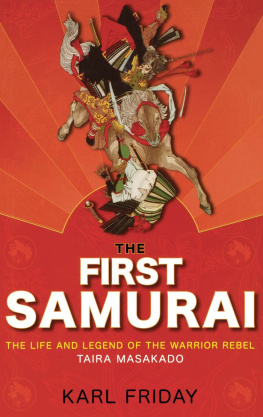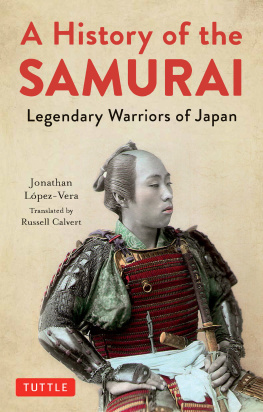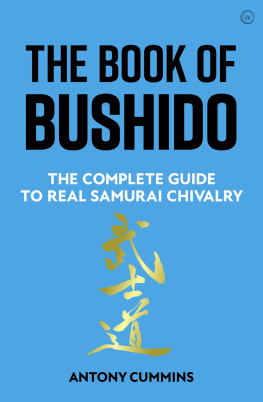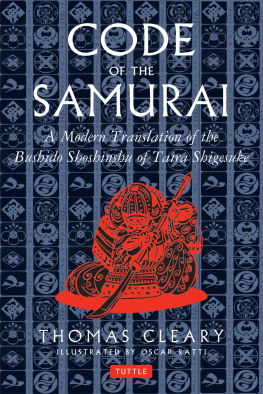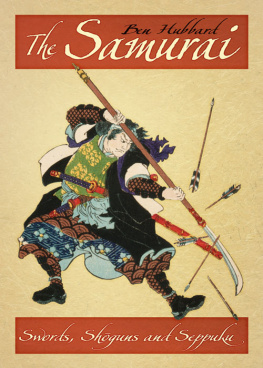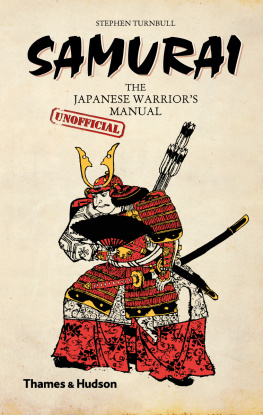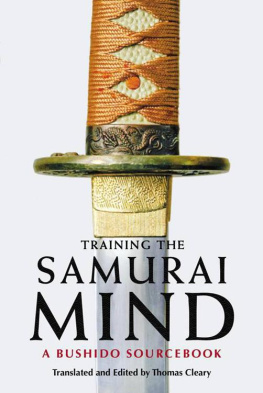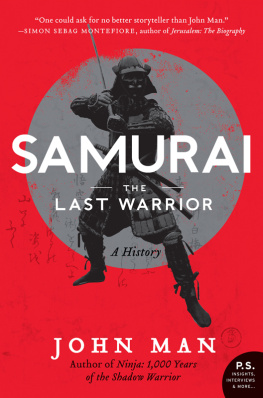THE
FIRST
SAMURAI
THE
FIRST
SAMURAI
THE LIFE AND LEGEND OF THE WARRIOR REBEL
TAIRA MASAKADO
KARL F. FRIDAY

This book is printed on acid-free paper. 
Copyright 2008 by Karl F. Friday All rights reserved
All illustrations and maps Karl F. Friday.
Published by John Wiley & Sons, Inc., Hoboken, New Jersey
Published simultaneously in Canada
Wiley Bicentennial Logo: Richard J. Pacifico
Design and composition by Navta Associates, Inc.
No part of this publication may be reproduced, stored in a retrieval system, or transmitted in any form or by any means, electronic, mechanical, photocopying, recording, scanning, or otherwise, except as permitted under Section 107 or 108 of the 1976 United States Copyright Act, without either the prior written permission of the Publisher, or authorization through payment of the appropriate per-copy fee to the Copyright Clearance Center, 222 Rosewood Drive, Danvers, MA 01923, (978) 750-8400, fax (978) 646-8600, or on the web at www.copyright.com. Requests to the Publisher for permission should be addressed to the Permissions Department, John Wiley & Sons, Inc., 111 River Street, Hoboken, NJ 07030, (201) 748-6011, fax (201) 748-6008, or online at http://www.wiley.com/go/permissions.
Limit of Liability/Disclaimer of Warranty: While the publisher and the author have used their best efforts in preparing this book, they make no representations or warranties with respect to the accuracy or completeness of the contents of this book and specifically disclaim any implied warranties of merchantability or fitness for a particular purpose. No warranty may be created or extended by sales representatives or written sales materials. The advice and strategies contained herein may not be suitable for your situation. You should consult with a professional where appropriate. Neither the publisher nor the author shall be liable for any loss of profit or any other commercial damages, including but not limited to special, incidental, consequential, or other damages.
For general information about our other products and services, please contact our Customer Care Department within the United States at (800) 762-2974, outside the United States at (317) 572-3993 or fax (317) 572-4002.
Library of Congress Cataloging-in-Publication Data:
Friday, Karl F.
The first samurai : the life and legend of the warrior rebel Taira Masakado
/ Karl F. Friday.
p. cm.
Includes bibliographical references and index.
ISBN 978-0-471-76082-5 (cloth: alk. paper)
1. Taira, Masakado, 903 or 4-940. 2. GeneralsJapanBiography. 3. JapanHistoryTengyo Revolt, 938-940. I. Title.
DS852.T3F75 2007
952'.01092dc22
2007035510
10 9 8 7 6 5 4 3 2 1
For Chie, who makes it all worthwhile
Ambition is an idol, on whose wings great minds are carried
only to extreme; to be sublimely great or to be nothing.
Robert Southey
CONTENTS
ACKNOWLEDGMENTS
No book writes itself, and no author works entirely on his or her own. This project could not have been undertaken without help and support from dozens of friends and colleagues on both sides of the Pacific, to all of whom I express my profound appreciation and gratitude.
A special round of thanks goes to my editor, Stephen Power, and my production editor, Rachel Meyers, at John Wiley & Sons for shepherding the book from conception to publication; to Peter Hoffer for his advice and counsel throughout; and to Tanaka Atsuko, Nick Adams, Wendy Giminski, and Money Hickman for their work on the maps and illustrations that adorn this volume.
Some of the research for this study was funded by grants from the Japan Foundation, whose support I gratefully acknowledge. I am also deeply indebted to professors Kond Shigekazu, and Ishigami Eiichi and the rest of the faculty and staff of the University of Tokyo Shiryhensanj who gave me a place to work and took time away from their own labors to assist me with mine.
This book is part of a larger project reexamining warrior rebellions in Heian Japan that began with a paper delivered at a conference held at Harvard University in June 2002. My thanks, therefore, to Mikael Adolphson and Edward Kamens, whose invitation to participate in this event got me started. And an extra thank-you goes to Mickey, for his invaluable bibliographic and editorial help.
Once again, however, my greatest debt is to Chie, my wife and the wind behind my sails. She listened patiently to my ideas, graciously ignored my frustrations, and kept me going with enthusiastic responses and cogent suggestions. Most important, she gives me a reason to go home at the end of each day.

Japan in the tenth century
Chapter 1
Masakado and His Legacy
The history we read, though based on facts, is,
strictly speaking, not factual at all, but a series
of accepted judgments.
Geoffrey Baraclough, History in a Changing World
Ignorance is the first requisite of the historian, ignorance
which simplifies and clarifies, which selects and omits.
Lytton Strachey, Eminent Victorians
On the twenty-fifth day of the second month of 940, according to the old lunar calendar,
Excitement, anticipation, and anxiety intensified over the next few weeks as further messengers reported that Hidesato and Sadamori were on their way to Kyoto, and rumors that Masakados warriors were
The gruesome custom of gathering enemy heads after a battle (buntori, literally taking ones share) became common practice in Japan at least as early as the seventh century, when the imperial state (ritsury) legal codes laid out a flexible point system for assessing battlefield merit and awarding promotions in rank. Points, explained the Statute on Military Defense (Gunbry), have no fixed meaning. In one years battles one point may require the taking of ten heads, while in another years fighting five heads can make a point.
By the tenth century, warfare and law enforcement had become the preserve of professional warriors who fought for rewards for their services paid by the government or private employers. Recompense, however, required proof of success, making careful accounting and confirmation of ones kills a matter of considerable importance. Warriors concocted numerous devices toward this end, ranging from marking arrows with their names to commissioning illustrated accounts of their exploits, but the cardinal warrior trophies throughout Japans premodern epoch were the heads of those they were contracted to run down. Heads were severed in the heat of battle, usually by means of a warriors short sword (katana), or in the aftermath, as a substitute for live prisoners when capture or transport of the latter was impractical. Heads collected in accord with government warrants were assembled, identified, marked with the names of their former owners, and brought to the capital for inspection. Those belonging to important criminals were paraded through the streets and placed on public display.
Hidesato and Sadamori reached the capital on the tenth day of the fifth month of 940 and entered the city through the Rashmon gate to the south, where they were met by envoys from the Office of Imperial Police (
Next page
